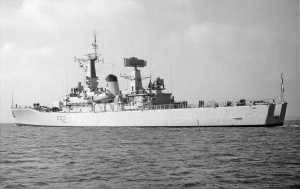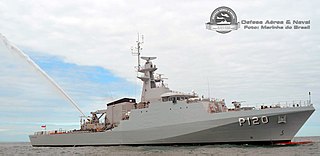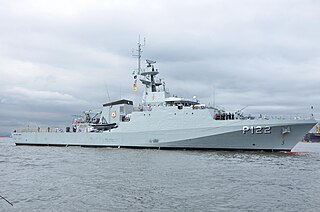
The Trinidad and Tobago Defence Force (TTDF) is the military organization responsible for the defence of the twin island Republic of Trinidad and Tobago. It consists of the Trinidad and Tobago Regiment, the Trinidad and Tobago Coast Guard, the Trinidad and Tobago Air Guard and the Defence Force Reserves.

A coast guard or coastguard is a maritime security organization of a particular country. The term embraces wide range of responsibilities in different countries, from being a heavily armed military force with customs and security duties to being a volunteer organization tasked with search and rescue without law enforcement authority. In most countries, a typical coast guard's functions are distinct from those of the navy and the transit police, while in certain countries has similarities to both.
A patrol boat is a relatively small naval vessel generally designed for coastal defence, border protection, immigration law-enforcement, search and rescue duties. There have been many designs for patrol boats. They may be operated by a nation's navy, coast guard, police force or customs and may be intended for marine or estuarine or river environments. They are commonly found engaged in various border protection roles, including anti-smuggling, anti-piracy, fisheries patrols, and immigration law enforcement. They are also often called upon to participate in rescue operations.

HMS Juno was a Leander-class frigate of the Royal Navy (RN). Like the rest of the class, Juno was named after a figure of mythology. She was built by Thornycroft of Woolston, Hampshire. Juno was launched on 24 November 1965 and commissioned on 18 July 1967.

The Island-class patrol vessel was first designed and built for the Scottish Fisheries Protection Agency. As a result of the Royal Navy's experiences in the Cod Wars with Iceland, FPV Jura and FPV Westra were put in fishery protection patrols, the Navy built a further seven. These ships were designed and built by Hall Russell of Aberdeen, Scotland.
The Castle class was a class of British offshore patrol vessels of the Royal Navy. Two ships were constructed and after nearly 30 years service were sold to the Bangladesh Navy in 2010. The Bangladesh Navy upgraded these with more armaments including C-704 anti-ship missiles and sensors. These ships are now reclassified as corvettes by the Bangladesh Navy.

The River class is a class of offshore patrol vessels built primarily for the Royal Navy of the United Kingdom. A total of nine were built for the Royal Navy (RN), four Batch 1 and five Batch 2. One Batch 1 (HMS Clyde), which was the Falklands guard ship, was decommissioned and transferred at the end of its lease to the Royal Bahrain Naval Force.

HMS Mersey is a River-class offshore patrol vessel of the British Royal Navy. Named after the River Mersey, she is the fifth RN vessel to carry the name and the first to be named Mersey in 84 years. Various tenders were renamed Mersey during their service with Mersey Division Royal Naval Reserve between the early 1950s and late 1970s.

HMS Dumbarton Castle (P265) was an offshore patrol vessel of the British Royal Navy. Her main role was the protection of the offshore assets of the United Kingdom, including oil and gas installations and fisheries out to the 200-nautical-mile limit.

HMS Tyne is a River-class offshore patrol vessel built by Vosper Thornycroft in Southampton for the Royal Navy to serve as a fishery protection unit within the United Kingdom's waters along with her two sister ships Mersey and Severn. All three were commissioned into service in 2003 to replace the five older Island-class patrol vessels.

HMS Severn is a River-class offshore patrol vessel of the Royal Navy. Named after the River Severn, the ship is the first to bear the name in 56 years. She was built by Vosper Thornycroft in Southampton to serve primarily as a fishery protection unit within the United Kingdom's waters along with her two sister ships Mersey and Tyne. All three were commissioned into service in 2003 to replace the five older Island-class patrol vessels. The ship was decommissioned in 2017, but the Government decided to recommission her as part of Brexit preparedness. She returned to service in 2020 and was recommissioned into the Royal Navy on 28 August 2021.

BNS Turag is an Island-class offshore patrol vessel of the Bangladesh Navy. She has been serving in the Bangladesh Navy since 2004.

BNS Gomati is an Island-class offshore patrol vessel of the Bangladesh Navy. She was originally built as a Fishery Protection Vessel for the British Royal Navy, entering service as HMS Anglesey in 1979. She was sold to Bangladesh in 2002, entering service in 2003.

BNS Shaheed Ruhul Amin was an Island-class offshore patrol vessel of the Bangladesh Navy used as a training ship. She was built and served as a Royal Navy Island-class patrol vessel HMS Jersey (P295) from 1977 to 1993.

The Overseas Patrol Squadron is a front-line squadron of the Royal Navy with responsibility for patrolling the UK's Extended Fisheries Zone, both at home and around British Overseas Territories. The squadron, with headquarters at HMNB Portsmouth, is equipped with eight of the River-class patrol vessels.

The Cape class is a ship class of 18 large patrol boats operated by the Marine Unit of the Australian Border Force, the Royal Australian Navy (RAN) and the Trinidad and Tobago Coast Guard. Ordered in 2011, the vessels were built by Austal to replace Customs' Bay-class patrol boats, and entered service from 2013 onwards. Following availability issues with the Armidale class, two vessels were chartered by the RAN from mid-2015 to late 2016. A further two vessels were ordered at the end of 2015 by the National Australia Bank, who will charter the patrol boats to the Department of Defence from completion in 2017. 2 vessels were ordered by Trinidad and Tobago for their coast guard in 2018 with the vessels delivered in 2021. A further six vessels were ordered for the RAN in 2020.

HMS Forth is a Batch 2 River-class offshore patrol vessel in active service with the Royal Navy. Named after the River Forth, she is the first Batch 2 River-class vessel to be built. She was commissioned into the Royal Navy on 13 April 2018, following a commissioning ceremony at her homeport HMNB Portsmouth. In January 2020 she replaced HMS Clyde as the Falklands patrol ship.

Amazonas (P-120) is a Amazonas-class corvette currently operated by the Brazilian Navy. She was originated named Port of Spain (CG50) while she was being built for the Trinidad and Tobago Coast Guard.

Apa (P-121) is a Amazonas-class corvette currently operated by the Brazilian Navy. She was originated named Scarborough (CG51) while she was being built for the Trinidad and Tobago Coast Guard.

Araguari (P-122) is a Amazonas-class corvette currently operated by the Brazilian Navy. She was originated named San Fernando (CG52) while she was being built for the Trinidad and Tobago Coast Guard.














